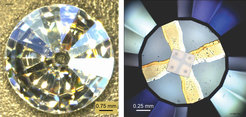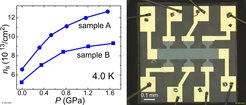Hydrostatic Pressure Response of an Oxide Two-Dimensional Electron System
Hydrostatic pressure has the capability of fundamentally changing key properties of quantum matter. Pressure, for example, can alter bond lengths and angles, and thereby control electronic conduction. The possibility to study the electronic transport of quantum matter films and heterostructures under large applied pressure has been severely limited due to considerable experimental challenges.
Using diamond-anvil cells and a piston-cylinder instrument, we have developed a method to apply hydrostatic pressure of several gigapascals (1 GPa=109 Pa) to quantum matter heterostructures, which have been patterned into devices (arXiv 1605.08528 and Phys. Rev. B 93, 235117, 2016).
Applying this technology, we studied the electronic transport of the two-dimensional electron system at the interface between LaAlO3 and SrTiO3. We find that a pressure of 2 GPa (= 20 kbar) is sufficient to produce a large and reversible effect on the electron system: at low temperature, the carrier density doubles with increasing pressure. First-principles calculations accompanying the studies pinpoint this behavior to a pressure-induced decrease of lattice distortions in the LaAlO3 layer.
We are now applying this technology to tune quantum matter devices by applying higher pressure.
This work was done in close collaboration with the groups of T. Kopp (Augsburg University) and R. Valentí (Goethe University Frankfurt).


Fig. right: Optical microscopy image of a sample in Hall bar configuration used for pressure experiments in the piston cylinder cell.

